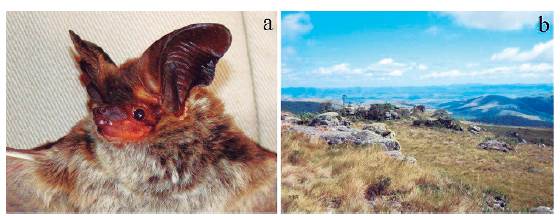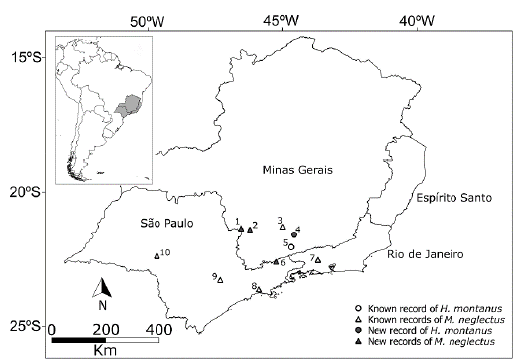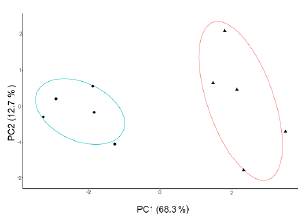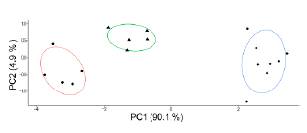INTRODUCTION
Scientific data on mammal species diversity has increased in the last 20 years due to the description of new taxa and systematic reviews based on the Phylogenetic Species Concept (Groves 2004). As a result, the Neotropics continues to be the most diverse zoogeographical region regarding mammals with two orders, Rodentia and Chiroptera, presenting both highest species richness and taxonomic description rates (Burgin et al. 2018). Besides revisionary studies, accurate estimative of bat diversity depends on analysis of samples collected in remote areas that also provide new natural history data; taxonomic identification also benefits from molecular technics such as barcoding (Galimberti et al. 2015), as well as updated identification keys allowing more confidence in the identification of the species (Gregorin and Taddei 2002, Gardner 2008, Díaz et al. 2016, López-Baucells et al. 2016). Thus, it is expected that new taxa and new geographical records would be revealed, enlightening our knowledge about distribution, phenotypical variation, and natural history data in South American bat taxa.
This is particularly true for some insectivore aerial bats from the families Thyropteridae, Natalidae, Emballonuri-dae, Vespertilionidae, and Molossidae. The last two families have some genera relatively easy to find (e.g. Molossus, Eptesicus, and Myotis), while others are rarely collected. Here we provide new records of Histiotus montanus (Philippi & Landbeck, 1861) (Vespertilionidae) with comments on external morphology and new ectoparasite-host associations for this species, and new records of Molossops neglectusWilliams & Genoways, 1980 (Molossidae) with morphometric analysis in the genus Molossops to better understand the geographical variation in this species.
MATERIAL AND METHODS
The analyzed material is housed at the Colecao de Mamíferos da Universidade Federal de Lavras, Minas Gerais, Brazil (CMUFLA), the American Museum of Natural History, New York, USA (AMNH), and the Royal Ontario Museum, Toronto, Canada (Appendix 1). Morphometric data of the holotype of Molossops neglectus was obtained from the original description (Williams and Genoways 1980). The selected measurements are according to Gregorin and Loureiro (2011), as follows: FAL - greatest length of forearm, GLS - greatest length of skull, C-M - upper toothrow length, BCB - braincase width, POB - post-orbital width, ZBR - zygomatic breadth, M-M - width between second upper molars, c-m - lower toothrow length, and MAL - greatest length of mandible. In order to visualize the morphometric variation, a Principal Component Analysis (PCA) was performed using a variance-covariance matrix. Only adult, based on the ossification of metacar-pals and phalanxes, female specimens were considered for PCA analysis due to the limited sampling for adult males (only one male was analyzed). All data were log-transformed for statistical tests (Gregorin et al. 2016).
We performed two PCA rounds (Brown and Wicker 2000) for Molossops. The first analysis included M. temminckii (Burmeister, 1854) from Argentina, Paraguay, and Bolivia, and M. neglectus from southern (southeastern Brazil) and northern (Suriname and Guyana) South America (Appendix 1). This analysis was intended to determine the distribution of individuals in the vectorial space comparing both species, particularly the distribution of both M. neglectus southern and northern groups using other species as a reference. The variable c-m was excluded from this analysis due to its absence in our M. temminckii samples. The second analysis only included samples of M. neglectus, it was performed using all nine variables, including c-m, and was intended to determine the distribution of both geographical groups of M. neglectus in the vectorial space. All analyses were performed in R software (R Core Team c2016).
RESULTS
We recorded H. montanus from one adult male (CMUFLA 3024, Fig. 1a) collected in Chapada do Abanador, municipality of Minduri, state of Minas Gerais (Fig. 2). The climate of Chapada do Abanador is mild to cold reaching 4-5 oC in the winter. The area is located at 1549 m of altitude, and it is covered by "campo de altitude" at the plateau, a typical grassland vegetation that grows in high altitudes and over rocky formation (Fig. 1b), and semideciduous forest at the hillsides (Moras et al. 2013a). This habitat is similar to that recorded by Carvalho et al. (2013) for the Parque Estadual da Serra do Papagaio, at the limits between Minas Gerais and São Paulo states. The specimen was identified based on the following external characters: 1) Ears more elliptical than triangulars, 2) cocoa brown instead of light brown ears, 3) Distance between ears (6 mm) with a very low membrane (0.6 mm) connecting them, and 4) very narrow inner fold of ears, about 19 % of total width of ear, and not reaching the nostrils. This set of morphological characters warrants the identification of H. montanus in accordance with other authors (Gardner 2008, Carvalho et al. 2013, Díaz et al. 2016). The diagnosis of H. montanus was also facilitated by direct comparison with one specimen of H. velatus (Geoffroy, 1824) (CMUFLA 132) from the lower stratum of Chapada do Abanador (900 m). Morphological differences between both species were also confirmed by comparison of specimens of H. velatus (CMUFLA 2327) from Parque Estadual da Serra do Papagaio collected at 1640 m and H. montanus record by Carvalho et al. (2013) from the same region, but up to 2192 m (Fig. 2).

Figure 1 Habitus and habitat of Histiotus montanus. a. H. montanus (CMUFLA 3024), note the deep orange-pigmented face; b. "Campo de altitude" vegetation with rocky outcrops at up 1500 m in the study area. Credits: Aloysio Souza de Moura.

Figure 2 Records of Histtotus montanus and Molossops neglectus in the states of southeastern Brazil. 1 - Muzambinho (21°21'9.17"S -46°31'24.22"W, 990 m); 2 - Areado (21°23'44''S - 46°11'36"W, 826 m); 3 - Lavras (21°17'29''S - 44°59'13''W, 967 m); 4 - Chapada do Abanador, Minduri (21°35'39''S - 44°34'04''W, 1549 m); 5 - Parque Estadual da Serra do Papagaio, Itamonte (22°8'28.5''S - 44°43'36.49''W, 1640 m); 6 - Piquete (22°36'01''S - 45°13'16''W, 890 m); 7 - Engenheiro Paulo de Frontin (22°32'S - 43°41'W, 703 m); 8 - Estação Biológica de Boracéia, Salesópolis (23°38'S - 45°52'W, 936 m); 9 - Itú (23°15'S - 47°18'W, 597 m); 10 - Estação Ecológica de Caetetus, Gália (22°26'S - 49°44'W, 530 m).
Additional records of M. neglectus to southeastern Brazil were based on the capture of five specimens from three distinct sites (Fig. 2, Appendix 1). One specimen (CMUFLA 2491) comes from Piquete, Serra da Mantiqueira, a mountainous region bordering the states of Minas Gerais and São Paulo. Three specimens (CMUFLA 3142, 3143, 3156) were collected in Muzambinho and one (CMUFLA 3140) in Areado; both are very close municipalities in the southern state of Minas Gerais (Fig. 2). Individuals from Piquete and Muzambinho were netted in periurban areas and the individual from Areado was captured in a highly fragmented landscape.
Body dimensions of specimens of M. neglectus from southern (Table 1) are smaller when compared with northern samples (Fig. 3). PCA analyses, including or not M. temminckii (Figs. 3 and 4), resulted in a clear distinction between northern and southern samples of M. neglectus regarding size as indicated by PC1 (Fig. 4). When only M. neglectus individuals were included the distinction was clear, but even including M. temminckii, the distinction of both geographical groups of M. neglectus was observed though smaller. In the first analysis, including M. temminckii, PC1, that indicated size, was responsible for 90.1 % and PC2 for 4.9 % of total variation (Table 2). In the second analysis, including M. neglectus specimens only, PC1 was responsible for 68.3 % of variation and PC2 for 12.7 % (Table 2).
Table 1 Measurements of specimens of new records of Histiotus montanus and Molossops neglectus. For detail of specimen collection data see Appendix 1. CMUFLA = code of the museum, FAL = greatest length of forearm, GLS = greatest length of skull, C-M = upper toothrow length, BCB = braincase width, POB = post-orbital width, ZBR = zygomatic breadth, M-M = width between second upper molars, c-m = lower toothrow length, and MAL = greatest length of mandible.
| CMUFLA | sex | FAL | GLS | CIL | C-M | BCB | POB | ZBR | M-M | c-m | MAL |
|---|---|---|---|---|---|---|---|---|---|---|---|
| Histiotus montanus | |||||||||||
| 3024 | M | 48.4 | 18.4 | 17.6 | 6.5 | 8.2 | 4.2 | 10.9 | 7.1 | 6.8 | 12.5 |
| Molossops negíectus | |||||||||||
| 2491 | M | 36.1 | 16.4 | 16.2 | 6.5 | 8.7 | 4.8 | 11.3 | 8.2 | 7.0 | 12.6 |
| 3140 | F | 35.3 | 14.7 | 14.8 | 5.9 | 7.9 | 4.4 | 9.9 | 6.8 | 6.2 | 11.7 |
| 3142 | F | 36.4 | 15.3 | 15.2 | 6.1 | 8.0 | 4.3 | 9.9 | 7.2 | 6.7 | 11.5 |
| 3143 | F | 35.7 | 15.0 | 14.9 | 5.9 | 7.8 | 4.3 | --- | 7.2 | 6.5 | --- |
| 3156 | F | 36.7 | --- | - | - | - | - | - | - | - | - |

Figure 3 Plot of the first and second principal components based on nine external, skull, dentition, and mandibular variables for females of Molossops neglectus including n°rthern (triangles) and s°uthern (circles) samples only.
DISCUSSION
Morphologic distinctiveness
Histiotus montanus - Histiotus is a South American ves-pertilionid bat genus composed of eight species, with five species occurring in Brazil (Simmons 2005, Feijó et al. 2015). The range of H. montanus includes colder areas of Andes from Venezuela and Colombia to southern South America in Argentina, Chile, and Uruguay, and scarce records along southern Brazil, in the states of Santa Catarina (Cherem et al. 2004), Paraná (Miranda et al. 2006), and Rio Grande do Sul (Fabián et al. 2006). Recent distributional studies in Brazil have extended the range of the species to the state of Minas Gerais, southeastern Brazil (Carvalho et al. 2013). Histiotus montanus and H. vela-tus show geographical overlap throughout most southern Brazil and in the state of Minas Gerais, but Carvalho et al. (2013) stated that the distribution of Histiotus is misunderstood and new data mainly from high elevation sites in Brazil and accurate identification revisions are needed. Indeed, Moras et al. (2013a) worked in the high elevation region in southern Minas Gerais, and they netted fifteen individuals of Histiotus with similar morphology, and all individuals were primarily identified as H. velatus by the authors. Our review of the unique voucher (CMUFLA 3024) (Fig. 1) revealed that it belongs to H. montanus instead, the second record of this species to Minas Gerais state. Based on the records in literature (Andean region of Venezuela, Chile, Bolivia, and Ecuador), high altitude in southeastern Atlantic forest, and high latitudes in South America like in Argentina, southern Brazil, and Uruguay (Bianconi and Pedro 2007), H. montanus is thought to occur in regions with mild to cold climate. In Minas Gerais state, for example, H. montanus occurs in upper altitudinal strata and it is replaced by H. velatus in lower elevations as recorded to Mantiqueira mountain chain (Carvalho et al. 2013) and Minduri as observed by us. We have only five records of H. montanus for Brazil, which the southernmost record was in Rio Grande do Sul state, a colder area with mean temperature 13-23 oC and lower altitude (218-800 m) (Fabián et al. 2006). Records of H. montanus from lower latitudes in the Minas Gerais state were based on specimens netted between 1500-2100 m. Finally, in intermediate latitudes as from Santa Catarina and Paraná states the specimens of H. montanus were captured between 900 and 1300 m (Cherem et al. 2004, Miranda et al. 2006). Thus, it seems that the occurrence of H. montanus in high lands of Brazil is proportionally opposite to the latitude.
An interesting observation regarding the morphology of H. montanus and H. velatus is the facial skin coloration. In both species, when the individuals were netted, the skin of the ventral side of the legs, face, and the base of the ears were orange (Fig. 1), but one day later the orange color disappeared in the fixed specimen, the facial and ears skin turned blackish, and the ventral portion of the legs yellowish-brown. We suspected that, as a hypothesis to be tested, the orange coloration is due to assimilation of some pigment, probably carotenoids coming from preyed arthropods and becoming saturated in the skin when the bats are alive. Vertebrates do not produce carotenoid pigments, and it is very rare to see them in mammals, being the pigment acquired by food and deposited in both skin and internal organs (Stahl and Sies 2003). For example, photosynthetic carotenoids are used by mammals in several ways such as avoid cellular oxidative damage, preserve macula of eyes, and promote skin color (Stahl and Sies 2003). The carotenoid takeover has already recorded in bats like Ectophylla alba Allen, 1892 conferring the yellow color in noseleaf and pinna (Galvan et al. 2016). Another possibility would be the saturation of pheomelalin, but the very quick change of skin coloration in mammals is unusual.
Ectoparasites
We also firstly recorded new ectoparasites occurring on H. montanus: bat fly Basilia producta Maa, 1968 (Nycteribiidae), and the mites Chiroptonyssus sp. (Mac-ronyssidae), Macronyssus aff. leislerianus (Macronyssidae), and Radfordiella desmodi Radovsky, 1967 (Macronyssidae). They were previously recorded on H. velatus by Moras et al. (2013b), but they must be considered as occurring in H. montanus from now on. Other species of Basilia have alreadybeen recorded to H.montanus, such as Basilia plaumanni Scott, 1940 (Nycteribiidae) (Graciolli 2004) and Basilia silvae (Brèthes, 1913) (Nycteribiidae) (Muñoz et al. 2002), but this is the first record for B. producta. The mites Chiroptonyssus haematophagus Fonseca, 1935 and Radfordiella sp. have already been recorded for H. velatus (Azevedo et al. 2002), but both genera are firstly recorded for H. montanus.
Molossops neglectus - The species was described based on one adult female from Suriname and since then a few records from Guyana, Venezuela, and Colombia have published (Eger 2008); Barquez et al. (1993) and Gregorin et al. (2004) recorded the species to Argentina and Brazilian states of São Paulo and Rio de Janeiro, configuring a disjunctive distribution of M. neglectus with samples from northern and southern South America. To date, there are no records in intermediary areas like the dry diagonal including Cerrado, Pantanal, Chaco, and Caatinga. Since Gregorin et al. (2004) additional records of M. neglectus to southern range have been done to Brazilian states of Rio Grande do Sul (Bernardi et al. 2007), Paraná (Gazarini and Bernardi 2007), Santa Catarina (Althoff et al. 2018), and northward to Minas Gerais (Gregorin and Loureiro 2011). Gregorin et al. (2004) suggested that samples from meridional distribution are putative new taxa distinct from samples of typical M. neglectus from northern South America, and a systematic review using molecular and morphological data is under development (R. Gregorin, pers. comm.). In fact, our PCA analyses (Figs. 3 and 4) showed that the females of M. neglectus from southern samples are sharply smaller than those from northern, as inferred by PC1, indicating at least a strong variation in size if not a new taxon.
Table 2 Scores of PCA analyses in Molossops temminckii and Molossops neglectus.
| Variables/analyses | M. temminckii + M. neglectus | M. neglectus | |||
|---|---|---|---|---|---|
| PC1 | PC2 | PC1 | PC2 | ||
| Variation % | 90.1 | 4.9 | 68.3 | 12.7 | |
| Eigenvalue | 7.20 | 0.38 | 6.14 | 1.14 | |
| FAL | -0.353 | 0.041 | 0.259 | -0.412 | |
| GLS | -0.367 | -0.175 | 0.396 | 0.094 | |
| C-M | -0.346 | -0.383 | 0.305 | 0.095 | |
| BCB | -0.355 | 0.258 | 0.325 | 0.104 | |
| POB | -0.316 | 0.823 | -0.048 | -0.876 | |
| ZBR | -0.365 | -0.129 | 0.387 | -0.077 | |
| M-M | -0.362 | -0.153 | 0.384 | -0.063 | |
| MAL | -0.358 | -0.186 | 0.369 | -0.080 | |
| c-m | - | - | 0.373 | 0.128 | |















